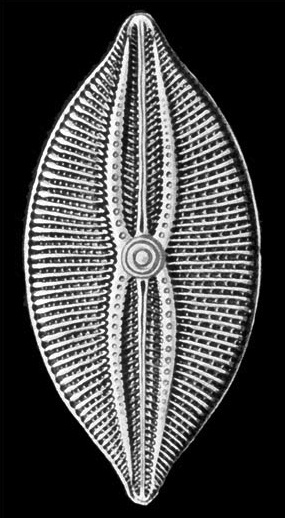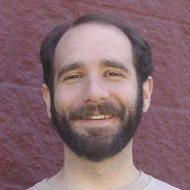A paper in the less-than-credible Journal of Cosmology claims to present evidence of life entering earth’s atmosphere from space. Phil Plait examines and nicely debunks the details, but there’s a creationist angle here, and even a link to climate science, and that’s as good an excuse as any to look at the paper.
 To summarize: researchers sent up a balloon, and brought it back with what they think looks like a diatom, from a height they claim it couldn’t have lofted to without volcanic assistance. They didn’t actually ask a diatom specialist to check whether a) it’s actually a diatom or b) it’s actually a known diatom from earth. (Diatoms are aquatic microbes that produce a microscopic rocky shell that preserves well. These shells can be found in lots of modern soils and preserved in ancient sandstone and limestone. These shells are used for lots of things, including the abrasive grit in toothpaste.) The claim that the supposed diatom is too big to have stayed afloat since the last big volcanic eruption is, as Plait notes, based on a model of the atmosphere that doesn’t incorporate the existence of wind, which is the sort of thing that seems worth incorporating. I’ll add that there’s good evidence that life can be lifted way up, and stay high up, for a long time. Researchers have found a surprisingly large microbiome (mostly of bacteria) in air samples collected 10 km above earth’s surface. As reported by Nature, these bacteria may play a significant role in the formation of clouds, ice crystals, and even raindrops, and these communities appear to be kept aloft or at least supplemented by the action of hurricanes. A piece of diatom (if that’s even what it is) at 27 km would be much higher, but doesn’t seem outside the realm of normal terrestrial events. Especially given the alternative proposed by the authors: “that the biological entities originated from space.”
To summarize: researchers sent up a balloon, and brought it back with what they think looks like a diatom, from a height they claim it couldn’t have lofted to without volcanic assistance. They didn’t actually ask a diatom specialist to check whether a) it’s actually a diatom or b) it’s actually a known diatom from earth. (Diatoms are aquatic microbes that produce a microscopic rocky shell that preserves well. These shells can be found in lots of modern soils and preserved in ancient sandstone and limestone. These shells are used for lots of things, including the abrasive grit in toothpaste.) The claim that the supposed diatom is too big to have stayed afloat since the last big volcanic eruption is, as Plait notes, based on a model of the atmosphere that doesn’t incorporate the existence of wind, which is the sort of thing that seems worth incorporating. I’ll add that there’s good evidence that life can be lifted way up, and stay high up, for a long time. Researchers have found a surprisingly large microbiome (mostly of bacteria) in air samples collected 10 km above earth’s surface. As reported by Nature, these bacteria may play a significant role in the formation of clouds, ice crystals, and even raindrops, and these communities appear to be kept aloft or at least supplemented by the action of hurricanes. A piece of diatom (if that’s even what it is) at 27 km would be much higher, but doesn’t seem outside the realm of normal terrestrial events. Especially given the alternative proposed by the authors: “that the biological entities originated from space.”
This is all well and good, and a fine bit of crank science to debunk. For a connoisseur of creationism, though, what jumps out here is the last author on the paper, one Chandra Wickramasinghe. Dr. Wickramasinghe has been vigorously pushing the idea of alien microbes for a long time, so long, in fact, that he was called as a witness by the creationist defense team in the 1981 case McLean v. Arkansas.
That case is older, and since it wasn’t appealed, it didn’t set a national legal precedent, but it deserves to be remembered. If you enjoyed tales of the Kitzmiller trial, you’d love McLean. Like Kitzmiller, McLean was a courtroom clash pitting the best anticreationist witnesses available against the best creationist witnesses available. (The Institute for Creation Research was unhappy with the policy and the case—as the Discovery Institute was unhappy with the Dover schools’ policy—and discouraged creationist witnesses from testifying; none withdrew at the last minute, as in Kitzmiller, but the A-list of creationists stayed home.) Kitzmiller’s lineup of plaintiffs’ witnesses was stunning, including Kevin Padian (paleontologist), Barbara Forrest (historian of creationism), Ken Miller (cell biologist), Brian Alters (science education specialist), Rob Pennock (philosophy of science), and Jack Haught (theologian). Hard to imagine better—but imagine that you had paleontologist Stephen Jay Gould, historian Ron Numbers (who wrote the definitive history of creationism in America), geneticist Francisco Ayala (the former priest who went on to become president of AAAS), philosopher Michael Ruse, historian of evangelicalism George Marsden, sociologist of schools Dorothy Nelkin, biophysicist Harold Morowitz, theologian Langdon Gilkey, science curriculum developer William Mayer (of the Biological Sciences Curriculum Study) and geologist Brent Dalrymple (who wrote the book on the age of the earth). That was just part of the witness list in McLean.
Against that all-star cast of scientists and science communicators, the defenders of the Arkansas law requiring equal time for creationism and evolution in science classes brought the best witnesses they could (again, without the full support of the law’s major creationist backer, and with ICR’s chief counsel discouraging witnesses from testifying). By far the best-credentialed witness for the creationists was Wickramasinghe. He was an acknowledged expert in astronomy, with scores of papers in top journals, and a long-time collaborator with Fred Hoyle (the coiner of the infamous “tornado in the junkyard” analogy beloved by creationists and the derisive inventor of the term “Big Bang,” but also the co-discoverer of nucleosynthesis of elements in stars). Plus, as a Buddhist, he undercut the claim that the law’s defenders were pressing a sectarian Christian agenda.
So what did Wickramasinghe have to say for himself in the first court case involving the constitutionality of teaching creation science in the public schools of the United States? Tune in next time for the exciting conclusion in…
“The Bride of It Came from Outer Space”

